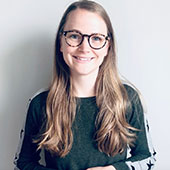Discovering Hidden Possibilities
Ellen Wilcox (MMM '20) shares how the MMM program helped hone the human-centered design approach she now leverages daily as a senior design lead at IDEO.
When is a toothbrush not just a tool to clean your teeth?
When it’s being tossed about in the mind of Ellen Wilcox (MMM ‘20), senior design lead at IDEO, the global design and innovation company. Part of her job is to help the cross-functional teams she leads overcome the brain’s tendency toward functional fixedness, a type of thought bias where people align objects only with their most common use. That type of locked-in thinking can lead to missed opportunities.
“We see a toothbrush and think ‘tooth brushing,’ not cleaning the grout of a bathroom or a wedding ring,” she said. “As adults, we lose our nimbleness when it comes to seeing objects in new ways, and it requires disciplined practice to break the functional fixedness mindset.”
 Wilcox combats that mindset with daily brainstorming sessions, where she comes up with as many possible uses for a given object, such as an oven mitt, colander, or book. The process helps her break down mental walls and "explore new, wacky possibilities beyond what I might have initially imagined,” she said.
Wilcox combats that mindset with daily brainstorming sessions, where she comes up with as many possible uses for a given object, such as an oven mitt, colander, or book. The process helps her break down mental walls and "explore new, wacky possibilities beyond what I might have initially imagined,” she said.
The MMM program — a dual-degree program between Northwestern Engineering and the Kellogg School of Management — initially appealed to Wilcox because at its core is the type of human-centered design that encourages outside-the-box thinking.
"The MMM program is dedicated to the pursuit of human-centered design thinking and the development of empathetic, creative business leaders who can take on the world’s ickiest, stickiest and most complex human problems,” she said. "It's a place where we live and breathe those tensions between human and business, rational and irrational, creative and analytical.”
Wilcox recognized the power of naming a need or problem in MMM. In her eyes, the strength of design research is not revealing mind-blowing insights, but rather presenting a challenge that was previously hard to articulate in a way that makes it designable. Without that, it's hard to solve a problem in a human-centered way.
For Wilcox, MMM was also about mastering the design thinking process.
"Design thinking is really a repeatable process that can be used across a wide range of design challenges," she said. "The key is knowing what the process is and how to move yourself and your team through it."
Wilcox implements that process on a daily basis at IDEO, where she's shown its effectiveness in myriad situations, including:
- Redesigning a law firm’s culture of feedback
- Directing investment strategy for a new patient-facing digital health tool
- Incorporating reflection as a brand differentiation strategy for a top business school
- Redirecting discretionary dollars toward BIPOC-owned businesses
As both a business designer and project lead, Wilcox strives to imagine what’s possible to meet consumer needs and also find a practical way from a business and strategy standpoint to turn those ideas into reality so all stakeholders win.
"At the end of the day, I work to help my clients make smart strategic decisions that solve complex human needs," she said.
One of the favorite parts of her job is its autonomy. As a business designer, she determines what tools, activities, workshops, frameworks, or ways of thinking could help clients make informed and strategic decisions. It's a level of autonomy that requires strong business design intuition.
Wilcox credits MMM with helping her develop that intuition.
"MMM gave me the confidence to truly own the business design craft and push on its creative edges," she said, "deepening my design research toolkit, evolving my visual design chops, building my 'scrappy, not crappy' prototyping skills, and collaborating with other creative minds to get it all done, together."
